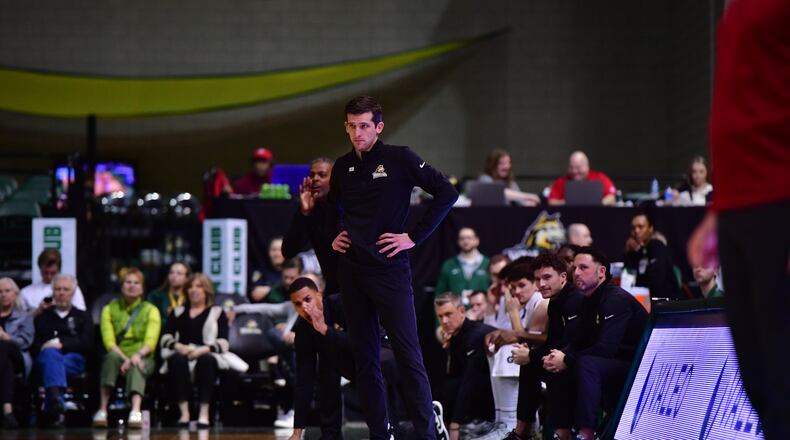But Wright State coach Clint Sargent was desperate enough after a rough first season to reach out to his peers in the hopes of getting some help. And he did.
They may not have shared EVERYTHING behind the curtain, but they made a rookie coach feel much more prepared to tackle year two.
“I bothered so many people, bombarding them with questions. Ben McCollum at Iowa — I picked his brain — Cleveland State’s coach (Rob Summers) and Rob Senderoff at Kent, just to name a few,” Sargent said.
“Guys were really gracious with their time. Plus, there were a few international coaches who I really like how they teach ball-screen coverage, how they pick up the ball. We’re trying to be something different based on our personnel.”
The Raiders’ problem while going 15-18 was something that’s plagued them the last three years while finishing with quarterfinal losses in the Horizon League tourney.
They were dynamic again on offense: sixth nationally in field-goal shooting (49.4%), 12th on 3-pointers (39.4%) and 82nd in points per game (77.3).
But they were 331st out of 364 teams in defensive efficiency (points allowed per possession) after finishing 341st a year ago.
They were 294th out of 364 teams in points allowed per game at 76.4 after finishing 341st in 2023-24 at 81.2.
He knew his team had to get more athletic, and he’s addressed that in the transfer portal.
Credit: Joseph R. Craven
Credit: Joseph R. Craven
But the key word this year is “disruptive.” He wants to create more havoc.
“That was such a key emphasis for me to learn in the offseason from other coaches, researching how can we get more disruptive? How do we get more disciplined with our hand and footwork? Those are things you need in order to be great defensively,” he said.
The Raiders finished 2-7 in games decided by four points or fewer, and they went 0-2 in OT games (those margins ended up being seven and eight points).
In other words, they just needed to flip a handful of possessions to have a rewarding season.
They were 10th in the Horizon League and tied for 290th nationally in steals per game at 5.7 and 10th in the league and 319th in the country in forcing turnovers at 10.2.
While the talks with coaches produced valuable insight, Sargent also reviewed tape of other programs that were shining in those disruptive stats.
Houston, known for its rapid defense and buy-in from players toward the less-glamourous parts of the game, was a particular favorite.
“I studied teams that maybe don’t overwhelm you with athleticism, but their turnover percentage is high and their steal rate is high,” he said.
“I do think we’re more athletic. We do have a higher upside at really all spots. Now, you have to bring the discipline and technique and understanding.”
Though practice is still a couple of weeks away, Sargent has had his full squad for summer and fall workouts. And scrimmages have been promising.
“Rebounding, steals and blocks — we stat all of that. I’ve compared those stats with last year’s summer and fall, and those three categories are significantly higher,” he said.
“It’s not perfect. But it at least gives me some type of benchmark where I can look and say, ‘Are we becoming what we need to become?’ This summer, those numbers were pretty alarming (in a good away). I feel like we’re making big strides there.”
About the Author

